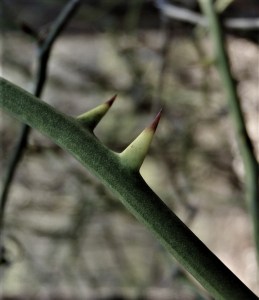by Tim Gilmore, 3/22/2017
I was joking when I told her I wanted to find the old man’s bearded head. She’d watched me for a moment, sly-smiled, and called me a resurrectionist.
Now she stepped down from the roaring road into the oystershell, greenbrier, saw-bladed palmetto and oak shade. She’d slipped into the ruins and it took me a moment to find her.
When I stepped beneath the old tabby wall, two sharp red points of greenbrier snagged my arm. I remembered that “tramp’s trouble” was another name for this vicious vine. I wondered how much trouble these relentless creepers had given Gonny when he tramped and toiled here a century ago.
Some random angered bramble had bloodied her too. I watched her dark ringlets cloud up with mosquitoes. The air buzzed and dripped.
Heckscher Drive hadn’t passed this little tabby house when Gonny Gonzales died in 1918 and dirt roads through this salt marsh grew back over quickly.
Perhaps it’s true Gonny died here at the house, though the other stories, particularly that long forgotten legend, seem less likely.
During the Florida Real Estate Boom of the ’20s, New York millionaire August Heckscher bought large swaths of this harsh terrain and marsh. With its sand and thorns and shell and salt and rich rainfall, the landscape stays both lush and barren, a desert jungle. Heckscher Drive opened in 1926.
Now both of us stood in the one-room house that never had a roof and noted how bright green were the new leaves of Muscadine grapevines that coiled about gnarled oak branches for a ceiling.
The century-old house measures only 22 feet by 12. It stands on an ancient Timucuan Indian shell midden, the garbage mound of centuries or millennia of the Timucuans’ marsh shellfish diet.
It was also from this midden that scaly old recluse made his living. The metaphor becomes more apt for its literal truth. Gonny spent his years here, on the west bank of Sisters Creek, digging up the island on which he lived. For years, he dug up the foundation beneath his feet, loaded the shell rock on a barge, and towed it to Jacksonville to sell for construction material.
That barge moved slowly, the ancient bedrock of Timucuan garbage afloat on the St. Johns River. What Gonny had quarried of the ground that upheld him he towed upriver downtown.
And she reminded me, she said, “You’re looking for the head.”
I asked her why she called me a resurrectionist.
“Because that’s why you do what you do,” she said.
Flattered, I protested. It was a grisly addendum to my joke about finding Gonny’s head.
In Victorian London, Resurrectionists were body snatchers. They exhumed the recently deceased from graveyards and sold them to medical schools for examination and study.
I asked her if that was what she meant. She said I didn’t need her to explain it.
How long Gonny sold the foundation of his island for a living nobody knows, but it killed him while he built of it his home.
He mixed oyster shell, sand, and Portland cement for his tabby, while other tabby ruins, like the uncompleted house on Fort George Island, were constructed of poured oyster shell, sand, and lime. He never filled the windows or doors. A small space at ground level in the western wall would have fitted his fireplace. The walls he’d pitched for a gabled roof.
When Gonny lived here, harvested his home, and built his house, small wild horses still roamed these coastal marsh islands. The English botanists John Bartram and his son William had surveyed these marshlands and islands and written of herds of small wild horses in 1765. These horses ran wild until just after Gonny Gonzales died. Then managers of a Fort George Island golf course removed or euthanized the last wild horses in the 1920s in their preference for deadly toxic golf course pesticides.
Standing beside the fireplace, looking up at wild grapevines, we agreed without proof that miniature wild Florida horses had grazed in Gonny’s ruins sometime between his death and their euthanasia. We wondered how many alligators had moved through the house. Many, surely, but surely not so many: as rattlesnakes. We wondered how many owls had darted down from oaks to grasp a rat or small bird inside these walls. How many wild pigs have walked this room?
In 1986, an amateur folklorist named Terrence H.E. Webb, also known as THE Webb, Xeroxed and stapled a 10-page booklet called The Haunted Tabby House. While the publication mostly refers to the tabby house on Fort George Island, Webb gives the last page to the Gonzales ruins, Florida archaeological site # 8DU636.
In the pamphlet’s last paragraph, Webb attributes the story of Gonny’s head to William Marcus Jones, a widely respected and academically cited amateur archaeologist. The endnote for Jones’s story, however, says, “Willie Browne, a mutual friend of both Jones and Gonzales, related this story of Gonzales’ death.”
Perhaps Webb meant for Browne’s retelling of Jones’s story of Gonzales’s death to be his main source. It’s not clear. Perhaps Jones’s attribution of Browne’s story about Gonzales’s death would carry the greater credibility.
However Webb meant it, and however the story came to him, he writes, “Gonzales lived alone, so when some of his friends had not seen him for a while they went to check on his whereabouts.”
And she asked me again if I had found the head and called me a resurrectionist and said, “I know why you do what you do,” and I blushed and turned my head away and hoped someone someday would find my own head here.
Writes Webb, “When they arrived, they found his head, identifiable by the white beard, in the yard of the house.”
Now we stood beneath grapevines in the middle of the house and in the middle of the next sentence:
“Inside the partly built structure they found his bones which had been stripped clean by his pet opossums.”














